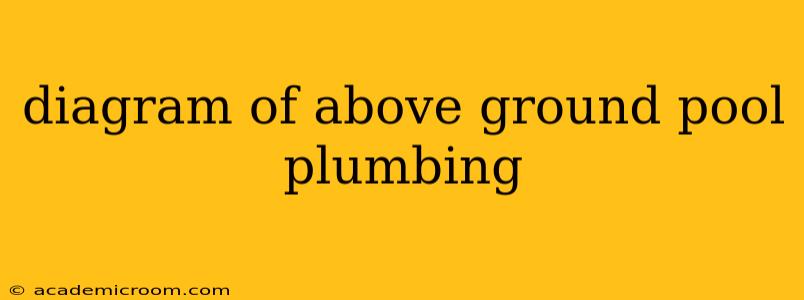Above ground pool plumbing might seem daunting at first glance, but understanding its basic components and flow is key to maintaining a clean, healthy, and enjoyable swimming experience. This guide will walk you through a typical above ground pool plumbing system, answering common questions and offering tips for optimal performance.
What are the main components of above ground pool plumbing?
A typical above ground pool plumbing system consists of several key components working together:
- Pump: The heart of the system, the pump circulates water through the filter and back into the pool. Its power dictates how quickly your pool filters and how effective its circulation is.
- Filter: This removes debris and contaminants from the pool water, keeping it clean and clear. Different filter types (sand, cartridge, DE) offer varying levels of filtration.
- Return Jets: These are the outlets that distribute the filtered water back into the pool, creating circulation. Proper placement is crucial for even distribution.
- Skimmer: Located at the water's surface, the skimmer collects floating debris and directs it to the pump and filter.
- Main Drain: Located at the bottom of the pool, the main drain helps with circulation and removes debris that settles on the pool floor. (Note: Some smaller above ground pools may not include a main drain.)
- Pipes and Fittings: These connect all the components, creating the pathway for water flow. Proper sizing and installation are vital for efficient circulation.
- Backwash System (for sand and DE filters): This allows you to periodically clean the filter media, removing trapped debris.
How does the water flow in an above ground pool plumbing system?
The water flow typically follows this path:
- Skimmer and Main Drain: Water is drawn from the pool's surface (skimmer) and bottom (main drain).
- Pump: The pump sucks the water and increases its pressure.
- Filter: The pressurized water is forced through the filter, removing contaminants.
- Return Jets: Clean, filtered water is pushed out through the return jets, circulating back into the pool.
This continuous cycle ensures clean and healthy pool water.
What size pump do I need for my above ground pool?
The appropriate pump size depends on the pool's volume and the desired turnover rate (how many times the entire pool volume is filtered in a day). Generally, a turnover rate of 6-8 hours is recommended. Consult the pool manufacturer's guidelines or a pool professional for accurate sizing recommendations.
How often should I backwash my filter?
The frequency of backwashing depends on the type of filter and how often you use your pool. Sand filters typically require backwashing every 1-2 weeks, while DE filters may need it every 2-4 weeks. Monitor your filter pressure gauge – a significant increase indicates it's time for backwashing.
What are common problems with above ground pool plumbing?
Common issues include:
- Low Water Flow: This can be due to a clogged filter, pump problems, or restricted pipes.
- Leaks: Leaks can be identified by a drop in water level or reduced pump pressure.
- Clogged Skimmer or Main Drain: These can restrict water flow and require cleaning.
- Pump Issues: Problems with the pump motor or impeller can significantly affect performance.
How can I troubleshoot problems with my above ground pool plumbing?
Troubleshooting often involves checking the following:
- Filter Pressure: A high pressure reading indicates a clogged filter.
- Pump Operation: Listen for unusual noises or check for proper impeller rotation.
- Pipes and Fittings: Inspect for leaks or blockages.
- Skimmer and Main Drain Baskets: Ensure these are free of debris.
If you can't resolve the issue yourself, consult a pool professional.
What are the different types of above ground pool filters?
The three main types of filters are:
- Sand Filters: Use sand as the filtering medium, relatively inexpensive to maintain.
- Cartridge Filters: Use replaceable filter cartridges, offering good filtration but requiring more frequent cleaning or replacement.
- DE (Diatomaceous Earth) Filters: Utilize a powder-like filtering medium for superior clarity, but they require more maintenance and specialized cleaning.
By understanding the components and principles of above ground pool plumbing, you can ensure your pool remains clean, safe, and enjoyable for years to come. Remember to consult professional help if you encounter any significant problems beyond your expertise.
